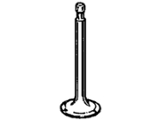The A-series engine cam followers were originally designed to use 0.010-in clearance between the cam follower and standard cams to allow for heat expansion of the parts and ensure the valves would close properly. On sportier and race profile cams this went up to 0.012-in to cater for the higher running temperatures and far higher rpm capability/use. Because we set the clearance at the valve, we need to allow for the rocker ratio. To do this a little simple math is involved; taking the standard 0.010" cam to follower clearance we need to multiply this by the standard rocker ratio originally quoted as 1.25-1, although in actual installation this is more like 1.22-1. So, 0.010-in x rocker ratio 1.25 gives 0.0125" at the valve.
As a concession to the slightly reduced installed ratio of 1.22-1, the standard valve clearance setting is quoted as 0.012-in. For the sportier/race cams this is then 0.012-in x 1.25 - so 0.015-in at the valve – the valve clearance quoted in Special Tuning manuals for the various cams of the time (731, 649, Sprint and Super Sprint).
Where higher ratio rockers are to be used, the required valve clearance can then be assessed using this simple formula. For instance when using 1.5 rockers, you obviously need to multiply the cam/follower clearance by 1.5. So 0.010-in x 1.5 gives 0.015-in for standard/mild cams and 0.012-in x 1.5 gives 0.018-in for race/more-modified cams. Interestingly, most re-profiled performance cams generally have a suggested valve clearance of 0.016-in with standard ratio rockers. To assess required valve clearance where higher ratio rockers are used simply work it backwards and multiply by the higher ratio. This works out as 0.016-in divided by 1.25 = 0.0128, then x 1.5 = 0.0192" - or 0.019" at the valve.
However, these are only basic starting points; but at least somewhere to start. Another interesting illustration of what trying different valve clearances will achieve is that demonstrated by the MG Metro engine. With valve clearances set, as you would normally expect for a standard engine at 0.012-in, the engine idles very roughly. Shortly after release, Rover published a technical up-date stating the valve clearances should be set at 0.014-in on the inlets and 0.017-in on the exhausts. Instantly the engine idles much smoother and pulls better from lower down. There was even a slight BHP gain!
A similar method can be applied to most cams that have different inlet and exhaust (dual pattern) profiles, i.e. having a slightly bigger clearance on the exhaust valves, or conversely slightly tighter on the inlet valves. However, as a basic initial set-up recommendation, depending on your cam spec, we suggest that where 1.5 ratio rockers are used set valve clearances on both inlet and exhaust to 0.015-in for standard or mild road cams (say up to MD266 spec) or 0.018-in for sportier/race cams.
One other point to note is where rockers with roller tips are used, DO NOT push the feeler blades through from the front as standard. The roller tip acts like a panel roller and will draw the blade through irrespective of gap size – even if there isn’t one. The feeler blade must be wiped sideways from one side to the other.
Setting the valve clearances consistently and accurately can be very frustrating, mainly caused by the tools used. It is imperative you use a screwdriver blade that fits snugly in the adjuster screw slot. A looser fit results in difficulty holding the adjuster screw in place when nipping the locknut up. Bearing in mind we are try to set clearances to one thousandth of an inch, it is well worth investing in a tool to specifically do this job. The problem is that most screwdrivers have a tapered blade resulting in a poor fit. Consider using a socket-mounted screwdriver tip can make this task much easier. You can either use a 3/8-in drive extension and ‘T’-bar or a 3/8-in drive screwdriver handle with it.









